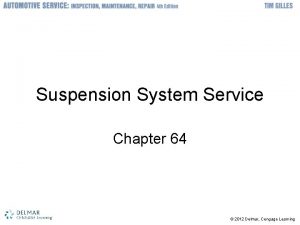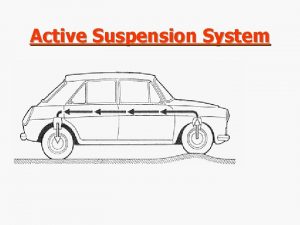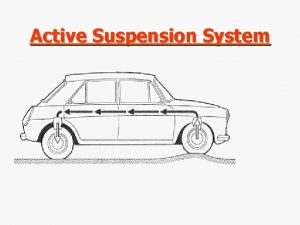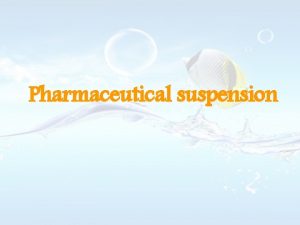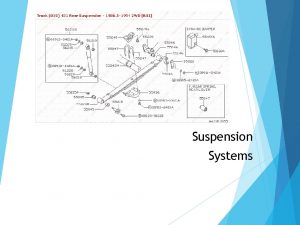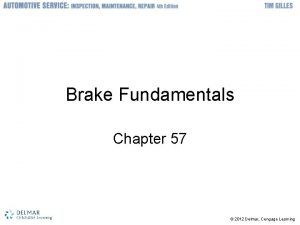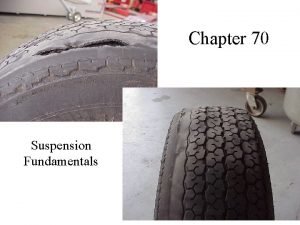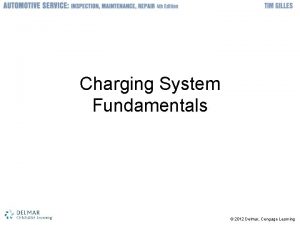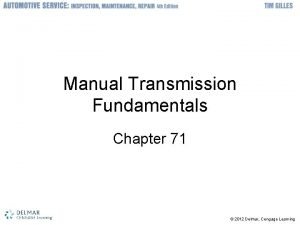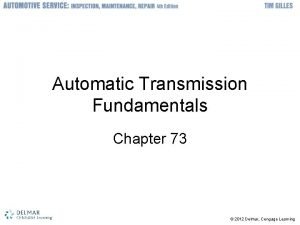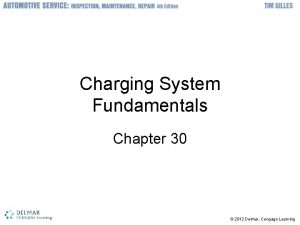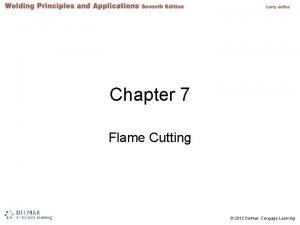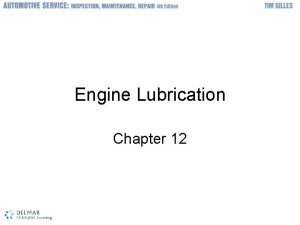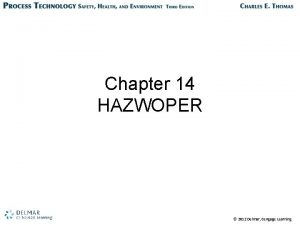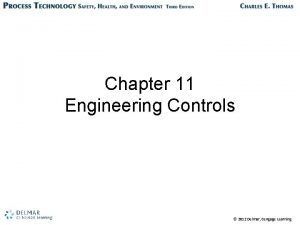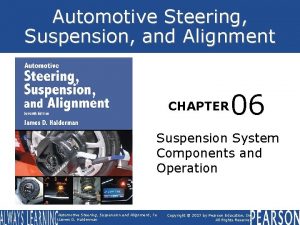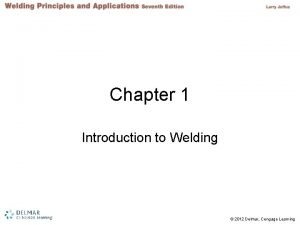Suspension Fundamentals Chapter 63 2012 Delmar Cengage Learning

























- Slides: 25

Suspension Fundamentals Chapter 63 © 2012 Delmar, Cengage Learning

Objectives • Identify parts of typical suspension systems • Describe the function of each suspension system component • Compare the various types of suspension systems © 2012 Delmar, Cengage Learning

Introduction • Vehicle chassis components – Frame – Shocks and springs – Steering parts – Tires, brakes, and wheels • Suspension system – Part of the chassis – Many designs and many part names • This chapter uses standard names © 2012 Delmar, Cengage Learning

Suspension • Supports the vehicle and cushions the ride – Holds tire and wheel in correct position • Sprung weight – Weight supported by car springs • Powertrain, body, and frame • Anything carried by the weight of springs • Unsprung weight – Reducing unsprung weight increases control • Tires, wheels, brakes, bearings, axels, and differential © 2012 Delmar, Cengage Learning

© 2012 Delmar, Cengage Learning

Frame and Suspension Designs • Cars are designed to be lightweight – Improves fuel economy • Newer cars have front-wheel drive – Older cars had rear-wheel drive • Front-wheel-drive cars – Unibody design • Sheet metal floor pan with small sections of frame at front and rear – Made with sub-frame • Includes engine, transaxle, and steering/suspension system © 2012 Delmar, Cengage Learning

Springs • Support the load of the car – Absorb the up-and-down motion of wheels • Coil spring: most common spring used in front and rear of passenger cars – Variable rate spring: becomes stiffer as compressed • Smoother ride over small bumps • Torsion bar spring: straight rod that twists when working as a spring – Mounted in the chassis © 2012 Delmar, Cengage Learning

Springs (cont'd. ) • Leaf spring: long, flat strip of spring steel rolled at both ends to accept rubber insulated bushing – As leaf spring is deflected it becomes stiffer • Air spring: rubber air chamber attached by tubing to an air compressor © 2012 Delmar, Cengage Learning

Suspension Construction • Solid axel suspensions – Wheel goes over a bump: other wheel also affected • Independent suspensions – Wheel goes over a bump: only that wheel is affected • Control arms – Used on independent suspensions – Allow springs to deflect © 2012 Delmar, Cengage Learning

Suspension Construction (cont’d. ) • Rubber bushings – Keep suspension parts separate • Ball joints – Attach control arm to spindle – Allows motion in two directions © 2012 Delmar, Cengage Learning

Suspension Types • Short and long arm suspension (SLA) – Two unequal control arms which are not parallel • Shorter control arm slants down toward outer end • Double wishbone suspensions have improved directional stability • Macpherson strut suspensions – Coil spring and shock absorber incorporated into front suspension • Single control arm on bottom • Spindle attached to strut housing • Strut bearing at top allows entire unit to rotate © 2012 Delmar, Cengage Learning

© 2012 Delmar, Cengage Learning

High-Performance Suspensions • Multilink suspension – Independent suspension with more than two control arms – Extra links keep wheel in more precise position during cornering and on bumps © 2012 Delmar, Cengage Learning

Shock Absorbers • One at each vehicle corner – Dampen spring oscillations • Convert spring energy into heat energy • Poor shock absorbers – Aggravate SUV rollovers • Especially top-heavy vehicles © 2012 Delmar, Cengage Learning

Hydraulic Shock Absorber Operation • One end attached to suspension – Other to car body or frame • Force oil through passageways controlled by valves – Generates hydraulic friction – Converts motion energy into heat energy • Two chambers with piston – Forces fluid through valve from one chamber to the other • Either twin-tube or monotube © 2012 Delmar, Cengage Learning

© 2012 Delmar, Cengage Learning

Compression and Rebound Resistance • Hydraulic shocks are sensitive to velocity – The faster the piston moves, the higher resistance • Compression damping – Controls unsprung weight • Works with spring to keep tire in contact with road surface • Rebound damping – Controls excess chassis motion as shock extends © 2012 Delmar, Cengage Learning

Bump Stops and Limiters • Shock absorber movement follows travel of vehicle suspension – Damage results if shocks or struts reach extreme travel limit • Shock absorber fluid aeration – Aeration: hydraulic fluid mixes with air – Shock must be installed in nearly vertical position © 2012 Delmar, Cengage Learning

Gas Shocks • Invented to control cavitation and hydraulic fluid foaming – Pressurizing oil column in shock absorber keeps the bubbles in the solution – Some gas shocks have pressurized gas-filled cell • Takes place of free air in normal shock • Rear shock absorbers on RWD vehicles: mounted in two ways – Slanted inward toward rear at top – One mounted in front of axle and the other behind © 2012 Delmar, Cengage Learning

© 2012 Delmar, Cengage Learning

Air Shocks/Leveling Devices • Shocks not designed to carry vehicle weight • Some aftermarket devices use shock absorbers to correct vehicle height – Air shocks – Coil springs mounted on outside of shock body • Disadvantages of leveling vehicle using shocks – Shocks and shock mounts prone to breakage • Coil spring shock prevents body roll © 2012 Delmar, Cengage Learning

Other Front End Parts • Other front end parts attached to suspension – Help control the ride • Stabilizers and strut rods – Insulated from front suspension parts with rubber bushings © 2012 Delmar, Cengage Learning

Stabilizer Bar • Connects lower control arms on both sides of vehicle – Reduces sway – Functions as a spring when car leans to one side – One wheel moves up: bar twists as it tries to move the other wheel along with it • Ball joints – Attach the control arm to spindle – On suspensions with two control arms: ball joints function as load carrier or follower © 2012 Delmar, Cengage Learning

Suspension Leveling Systems • System types – Passive systems: firm or soft ride – Electronically controlled systems: computer reacts to signals from sensors at wheels – Electronically controlled shock absorbers: variable valving – Magneto-rheological (MR) shock absorbers: use fluid that rapidly changes viscosity – Active suspensions: double-acting hydraulic cylinder at each wheel to keep vehicle level © 2012 Delmar, Cengage Learning

© 2012 Delmar, Cengage Learning
 Delmar cengage learning medical terminology
Delmar cengage learning medical terminology 2009 delmar cengage learning
2009 delmar cengage learning Introduction to medical terminology chapter 1
Introduction to medical terminology chapter 1 Graphing tpr
Graphing tpr 2009 delmar cengage learning
2009 delmar cengage learning Chapter 13 medical math assignment sheet
Chapter 13 medical math assignment sheet Chapter 10 cultural diversity
Chapter 10 cultural diversity Delmar cengage learning instructor resources
Delmar cengage learning instructor resources 2012 cengage learning
2012 cengage learning Delmar thomson learning
Delmar thomson learning Pharyngorrhea
Pharyngorrhea Vertical suspension therapy
Vertical suspension therapy Medical terminology chapter 5 learning exercises answers
Medical terminology chapter 5 learning exercises answers Cengage learning heart diagram
Cengage learning heart diagram South-western cengage learning
South-western cengage learning Cengage learning heart diagram
Cengage learning heart diagram Cengage learning australia
Cengage learning australia Whille
Whille Cengage learning
Cengage learning Wadsworth cengage learning
Wadsworth cengage learning Cengage learning
Cengage learning Cengage learning plant cell
Cengage learning plant cell Cengage learning
Cengage learning Cengage learning
Cengage learning Brooks cole cengage learning
Brooks cole cengage learning 2014 cengage learning accounting answers
2014 cengage learning accounting answers


























